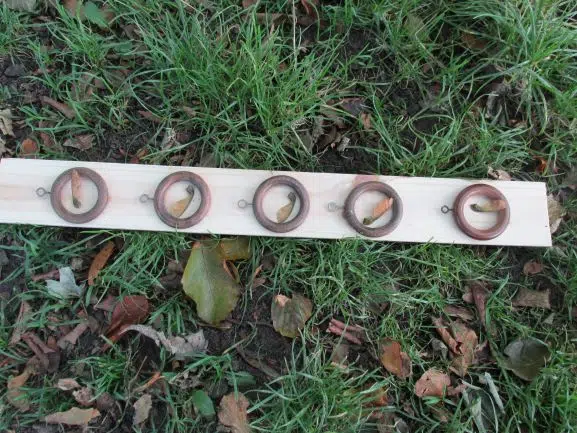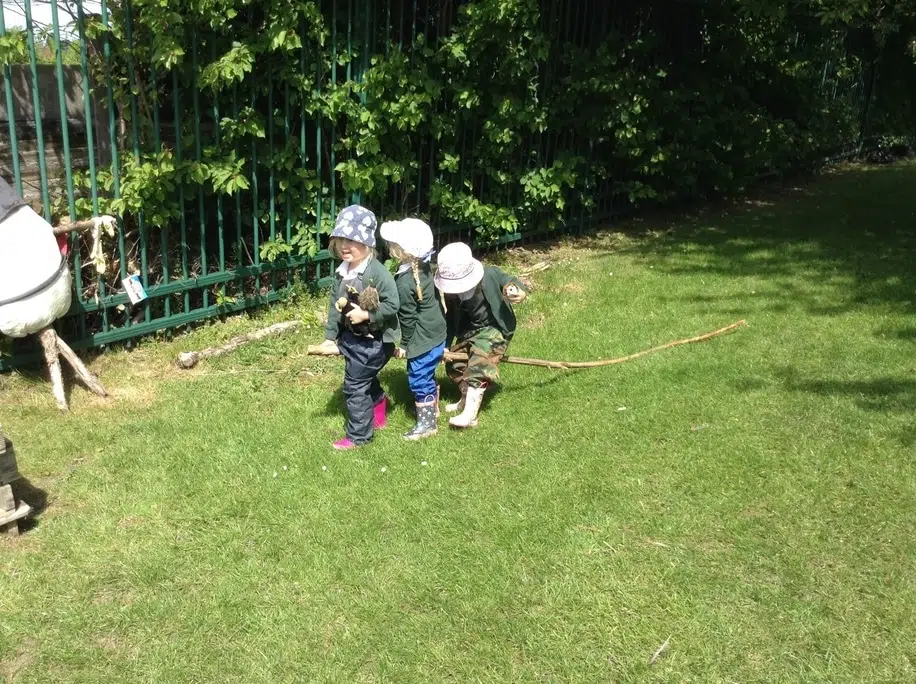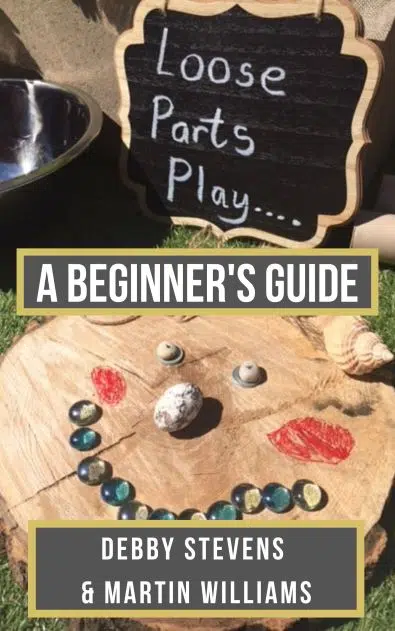If you are interested in loose parts play, you may well have wondered how to best support it outside.
How easily can it be achieved? What resources or skills do you need to get it going? What does loose parts play outside look like? What storage or budget may you need? Is it all worth it, and what benefits will it provide?
This full guide will answer all of these questions and more.
First, let me assure you that using loose parts play outside has numerous benefits. Some of the obvious ones include:
- It is quite cheap to set up
- It requires very little daily setting up
- The same resources can be used multiple times in different ways without the children getting bored
- It is an open-ended form of learning, and stimulates holistic development
- Children can get fully involved and focussed
- It can provide experiences across the curriculum
- It is fantastic at developing independence, vocabulary, PSED, and many other skills
Providing a learning environment that will stimulate loose parts play outdoors is relatively simple.
Let’s find out how to get started.

What Is Loose Parts Play?
First, let’s just quickly describe what loose parts play is, just so you definitely know.
Loose parts play is playing with objects that have no fixed purpose. For example, is you are playing with a stick it could be a:
- Wand
- Magic broomstick
- A person
- A light-sabre
- A snake
- Superworm
And many, many more things. Basically it is play with objects where the child gets to use them in no pre-defined way.
This type of play has multiple benefits for children. To give yourself a complete overview of the benefits of loose parts, as well as looking at what this looks like in reality, then why not check out my article – 14 Benefits of Loose Parts With Examples.
Why Outside?
The beauty of loose parts is that it works equally well either indoors or outside.
In fact I know many practitioners that use it much more outside. The reasons it works so well outside include:
- Outdoor learning works well as more open-ended than indoor learning in many settings
- Loose parts really support the natural outdoor instincts to build, climb and create
- There is a sense of scale that provides real excitement to children, that it is hard to replicate indoors.
- As children develop through school, the indoor learning environment will usually become more structured and focussed, with specific learning intentions. This is less often the case with outdoor learning. The open-endedness of loose parts play is perfect in exploring more free learning.
What Does Outdoor Loose Parts Involve?
In finding objects that will work well outdoors for loose parts, it is a good idea to think about the size. Simply put, outdoor play gives the opportunity to use things on a big scale.
You have more space to move and create large models.
There is the opportunity to build longer, wider and taller.
You can roll and manipulate objects over a wider area.
In short, outdoors = big!
A range of loose parts objects can be used in many different ways outside – for building, den-making, story creation, art, science, and many, many other ways as well.

What Resources Do You Need?
OK, let’s get down to the nitty gritty.
A lot of the best resources for outdoor loose parts will require little or no money. It is more a case of time and a bit of imagination. If you want to have a look at the kinds of resources that are great for loose parts in general then I have written an article with at least 100 ideas for materials you could use for loose parts play which you can check out here.
It really is a case of getting out there and seeing what you can find.
Beg from shops, borrow from local businesses.
You might be able to approach local businesses with the story of your setting. Many businesses are keen to help local educators. If you can’t find things, there is always the option of buying them.
Some excellent outdoor loose parts include some of the following:
- Boxes – These may be wooden, cardboard or similar. Ideally wooden boxes should be strong enough to be stood on
- Crates – These are a fantastic resource that will last a very long time. Beg or borrow from places like dairies, or from local shops. Or you can buy them from educational catalogues. They are excellent for building walkways, dens, and general construction
- Tyres – Again these can be sourced very cheaply, if not for free. Garages or tyre companies are the place to ask for them. You can get tyres of different sizes, and its great if you can. A selection of car tyres, bicycle tyres, truck tyres, and even potentially bigger would be perfect. Tyres are great for building, rolling, vehicle role-play and many more things
- Tubes – If you know a plumber then happy days! Scrapyards are another possibility for this kind of resource. Tubes are great for water play, and can also be used to roll things down. They can take on all sorts of roles in children’s open-ended play
- Wheels – This could be things like tricycle wheels, or wheels off old bikes. Parents may be happy to donate some things from this list, and these could definitely be one
- Materials
- Sheets – These can be used in all sorts of ways. Great for mark-making with loose parts (such as used different objects to paint with on the sheets). They are also excellent for building dens, and using them in construction
- Tree logs – Great for climbing, building and using as pretend vehicles (to name just a few ways). They could be found in a forest.
- Wooden blocks – Big wooden blocks provide all manner of open-ended learning experiences. Great for enhancing role-play and small world experiences, building, or simple representative play.
- Planks – These are great for making all sorts of weird and wonderful walkways, towers and the like. They are great used in conjunction with crates, boxes, gutters and other things
- Pipes – This is another one that could be sourced from scrap yards, builders yards, a local plumber, or any other range of sources.
- Large sticks – A very simple resource, but one of the most popular amongst children, and something that can be used in a staggeringly large number of ways.
- Gutters – These are fantastic for all sorts of open-ended STEM experiences. Roofing companies may be able to provide some, or keep some for you next time they remove some old ones from someone’s house.

These items that I have listed are all open-ended.
They can all be used by children for constructing, designing, problem solving, experimenting and testing their ideas.
Where to source materials from is always a big challenge, especially if you are on a tight budget. If you are based in the UK, then I would really recommend that you check out our training course Outdoors on a Budget.
Top Tip – For any outdoor loose parts material, ask yourself will this stimulate children’s own ideas and imagination, and can the objects be used in lots of different ways?
Storage
Space for storage is a big problem for lots of settings. However, there are many reasonably simple and economic solutions.
One good and cheap idea is using a probagator storage unit found in garden centres or DIY stores. These have shelving which is great for plant pots containing small loose parts. They also come with a cover so they can be left outside.
Try to find storage that is easy for children to access themselves (and also to enable them to tidy away themselves!).
Hunting around charity shops is a great way of finding some of the following which are excellent as storage solutions:
- Wicker baskets
- Crates
- Old chests
- Suitcases
- Shelving units
- Metal pots

Many schools and nurseries now used crates screwed to the wall as a simple, cheap and aesthetic storage providers.
Storying loose parts for babies is best done in wicker baskets (either indoors or outside). To find out more about treasure baskets, including what they are and how to use them, then check this out.
Top Tips For Storage
- Store
loose parts at the child’s height
- Ensure outdoor storage solutions are suitable for all conditions
- Children will have access to some loose parts all the time, and others stored away
- Start small in areas and expand the amount of loose parts over time
- Use aesthetically pleasing units and storage solutions if possible
How To Get Started
Right, so you know what outdoors loose parts play is, and also you’ve got some equipment to start it. What do you now need to do to get started?
There are a few tips to follow when you start using loose parts in either the indoor or outside environment.
These include:
- Start small. Don’t overwhelm the children with lots of brand new resources all at once. Start with a small selection and get them used to them first.
- Model some ways of using the equipment, and play alongside them. Although loose parts will hopefully be more child-led when the children get the idea, it can take some introducing to feed them with ideas and confidence to start with. This is particularly the case if children are not used to loose parts learning experiences.
- Model safety. Monitor how they use things like sticks carefully, and praise sensible practice
- Risk assess all objects that you bring into the setting
- Slowly build up the bank of resources as they gain exposure and confidence.
- Have big outdoor loose parts available to them all the time
- Have some loose parts that might be more of a special treat, and not available continually
We devote a big section to outdoor loose parts play in our book ‘Loose Parts Play – A Beginner’s Guide’. This is the ultimate guide to getting started with loose parts play successfully, and is packed with over 100 inspirational ideas. You can check out the book on Amazon here.

What Does Outdoor Loose Parts Play Look Like?
Here are some examples of the kind of thing that you might want to model, or hope to observe in children…
Construction
Children can use a range of objects to build:
- Dens
- Walkways
- Towers
- Castles
- Vehicles such as aeroplanes, trains or buses
- Superhero bases
Outdoor Investigating
This could be:
- Exploring floating and sinking with loose parts in a water tray
- Exploring shadows with random objects
- Exploring gravity by rolling objects down tubes, gutters or pipes
To find out a whole load more science loose parts play ideas then take a look at this article.
Outdoor Role-Play
Children can use the objects in all sorts of ways, for example:
- In making homes for real or imaginary characters, e.g. the gingerbread man
- Using props to support their play, e.g. sticks for skis
- Creating vehicles to go on trips to faraway lands, or recreate trips they have really been on
- To engage in the old classic – superhero play! They can create spiderman’s webs, or the superhero base. I wrote a whole article about 12 outdoor superhero play activities that you can read here.
Art
- They can use objects to create transient art, such as portraits on the floor
- They can create models and other creations
Physical Development
Children will be developing a range of physical skills through outdoor loose parts play. Some things you might see include:
- Making obstacle courses. They really enjoy making these. They build all sorts of walkways and obstacles and then you can have races with your friends. They sometimes like to add a narrative to the obstacle course, such as they are freeing someone from a baddy.
- The build using big loose parts and then will try to climb up them, balance on the top, and walk along them
- They build dens using all sorts of objects. Often they will run between dens, or go on missions where the den is the base to which they return.
- They roll, lift, balance, stack, and engage in all sorts of physical skills in multi-purpose ways.
Maths
Loose parts are excellent for developing many maths skills including:
- You get to understand the different weights and lengths of different objects
- You find out which objects roll and which don’t
- You explore the architecture of shape in reality when you build
- There are multiple opportunities for counting objects, and calculating – e.g. I need one more brick to finish the tower.
I have created a free ebook called ’50 Outdoor Number Activities On A Budget.’ This contains a whole host of outdoor math ideas in it, that you can download for free from here.
Outdoor maths is one of the most exciting ways to teach number skills, and you can find out 50 of the best outdoor maths activities here.
Outdoor Loose Parts Play At Different Ages
Outdoor loose parts play will look different depending on the age of the child. Here is a brief guide as to what it might look like:
Babies – Explore treasure baskets in an outdoor setting. To find out more about treasure basket play then check this out.
Children Aged 1-2 – Heuristic play using a range of everyday objects. Children can explore, investigate, and find out about the objects by moving them around in a given space.
Children Aged 2-5 – A range of more complex loose parts play experiences will be witnessed involving learning opportunities across the whole curriculum. There will be teamwork, and interacting with others (for the majority of children)
Children Aged 6+ – Children can still enjoy a range of big-scale adventurous loose parts experiences. These can be linked to opportunities to support other areas of the curriculum, such as literacy (though this is not essential)
Risk In Outdoor Play
Although loose parts play is not necessarily a very risky business, it is important to be aware of any risks that might happen when children engage in it outside.
Risky play is important for children. If you want to learn more about risky play activities for kids then some good articles to read are these:
Some of these risksof outdoor loose parts include:
- Building thing and falling off them
- Towers and constructions collapsing on them
- Getting stuck inside things
- Being hit by objects (either accidentally or on purpose)
Be aware of any children that are prone to throwing things, and try to monitor them.
The other things can normally be managed by just being aware of the risks, and getting children to think about them if they might occur.
It is not really a case of stopping children doing things all the time. It is more a case of getting them to think about their safety and that of others, and how this can best promoted.
To understand more about how to manage risk in loose parts play, then I recommend that you read this.
Benefits Of Risk For Children
There are numerous benefits for children in experiencing risk in play. Some of these include:
- Risky play is thrilling! It is exciting and can make children feel alive.
- They develop a healthy attitude to risk. Risk is an essential part of life. Studies have suggested that if children do not experience enough risk in their early lives it can either lead them to becoming risk averse, or alternatively even a risk-junky in later life!
- Risk can help children develop strong bonds with others. When several children take on a risky task together it strengthens the communication and the sense of teamwork between them
- They get to develop their sense of power and independence. In risky play children start to understand that they are in control of their own lives and their own decisions.
Even though, as I say, risky play is not really too risky by any stretch of the imagination, it can contain just an element of risk, and that is definitely a positive thing.
The Next Level
If you are passionate about loose parts play, and want to get started with it as successfully as possible, then check out our online course ‘Project Loose Parts’. This is a two-hour video course run by myself and Debby Stevens, demonstrating more than one-hundred practical provocations.
We also show you the step-by-step process to follow to successfully get set up with loose parts and avoid any of the many mishaps and pitfalls. You can find our ‘Project Loose Parts’ course page here.
Conclusion
Loose parts play lends itself brilliantly to outdoor learning. In the outdoors children have the space and freedom to really explore open-ended objects on a big scale, and let their imaginations really run wild.
They often get fully involved and engaged, and this develops skills across the whole curriculum and the whole child. Good luck with the outdoor loose parts!
Did You Know?
If you are reading this and live in the UK, you might want to check out our Loose Parts Play practical training course that we run at venues throughout England and Wales. This is open to both parents and educators. Here is a link to a description of that course.
This article is an expanded extracted from the book ‘Loose Parts Play – A Beginner’s Guide’ written by myself and my colleague Debby Stevens. This book provides a full, yet simple guide to setting up an outstanding loose parts culture in your home or educational setting with children aged 0-5. To check out the book on Amazon, then follow this link

